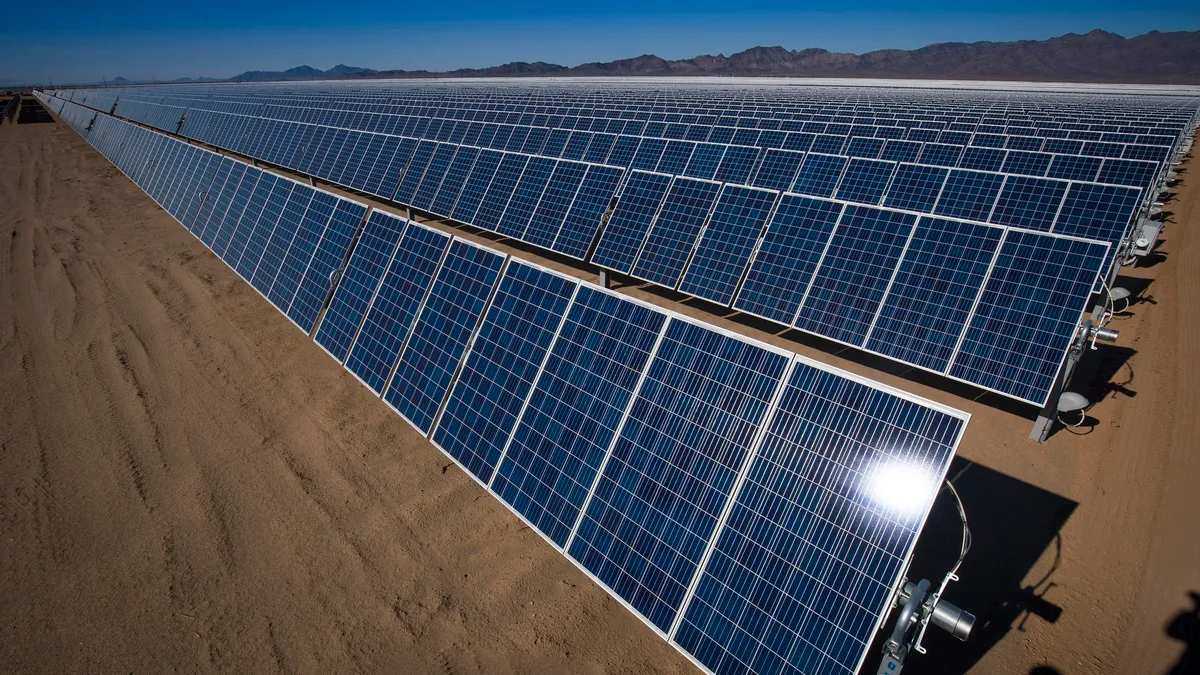Dive Brief:
- The California Air Resources Board, or CARB, proposed an update to its greenhouse gas reduction plan Nov. 16 that reflects state efforts to speed up carbon and air pollution reduction targets with more renewables, home electrification and zero-emission vehicles on the roads.
- CARB’s updated scoping plan projects that climate pollution will be 85% below 1990 levels and smog-forming pollution cut by 71% within 23 years. The draft update is the latest roadmap for the state to attain its target of a carbon-neutral economy by 2045 at the latest. This will be the third major update to the mandated greenhouse gas reduction scoping plan.
- The agency said that reaching the plan’s emissions goals won’t do away with residual emissions “from hard-to-abate industries such as cement, internal combustion vehicles still on the road and other sources of GHGs, including high global warming chemicals used as refrigerants.”
Dive Insight:
Gov. Gavin Newsom, D, called California air regulators' latest updated plan that seeks to accelerate carbon and toxic air pollution reductions in the state “the most ambitious set of climate goals of any jurisdiction in the world.” If approved, he said it will “spur an economic transformation akin to the industrial revolution.”
The updated draft plan would increase California’s mandate to cut greenhouse gases from the current 40% reduction below 1990 levels by 2030, to 48% below 1990 levels by the start of the new decade.
The revisions to the draft scoping plan pitched in June are in response to changes called for by the Air Board’s Environmental Justice Advisory Committee, new state laws and direction from Newsom, according to the board.
CARB acknowledged the challenges of moving the energy, transportation and other sectors to zero emissions. Chair Liane Randolph said the proposal “unequivocally presents challenging and ambitious goals, but we simply have no other choice but to meet them – and do it in less than a quarter century.”
Laura Deehan, Environment California’s state director, said “CARB’s new plan for global warming pollution reduction takes critical steps to accelerate the path to 100% clean energy that will ensure a healthier, safer and cleaner future here in the Golden State and beyond.”
Bill Magavern, Coalition for Clean Air policy director, also supports the clean energy measures but objects to CARB’s lack of implementation steps.
The plan seeks to slash health costs due to pollution by $200 billion by 2045. It also expects the transition to zero-emission stationary resources, and vehicles to create 4 million jobs.
In another boost for vehicle electrification in the state, on Nov. 17, the California Public Utilities Commission approved the state’s three investor-owned utilities spending $1 billion on chargers for electric light-duty vehicles and trucks between 2025-30, with a focus on reducing pollution in overburdened disadvantaged and tribal communities. Of the total amount, 70% is to fund chargers for medium- and heavy-duty truck ports. “This complements the $10 billion package we enacted to build out the infrastructure,” Newsom said on Thursday.
On the power generation side, the Air Board’s latest scoping plan would prohibit new gas-fired power plants to help reduce the electricity sector’s greenhouse gas emissions from 35 million metric tons in 2032 to 30 million metric tons by 2030, particularly to help lower pollution levels in struggling communities.
The plan assumes emissions from existing fossil plants will be reduced by carbon capture technologies and land-based natural sequestration. Many clean air advocates object to carbon capture and sequestration, or CCS, because these technologies have not successfully stored emissions long-term to date.
The Coalition for Clean Air disagrees “with the over-reliance on CCS,” Magavern said.
CARB’s 85% greenhouse gas emission reduction targets are projected to be met by a combination of other actions as well. They range from the growth in solar and wind resources, including 20 GW of offshore floating wind turbines installed by 2045, deployment of 6 million heat pumps by 2030, and 7 million climate-friendly homes in place by 2035. It also expects an expansion of the electric vehicle market — new and used — including from the ban on new gas-powered vehicle sales, and targets to reduce the amount of miles driven in the state.
Magavern said reaching the reduction target in vehicle miles traveled “will be difficult if the governor keeps vetoing most of the bills the Legislature passes to address the problem.”
CARB plans to vote on the updated scoping plan at its Dec. 15-16 meeting













